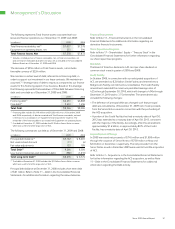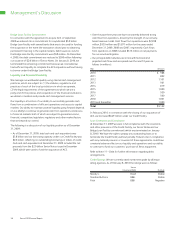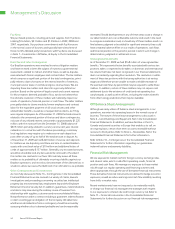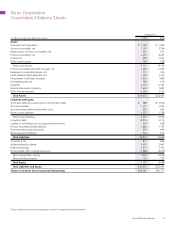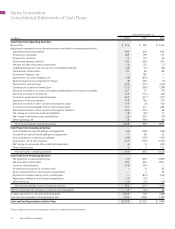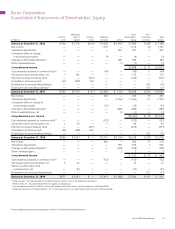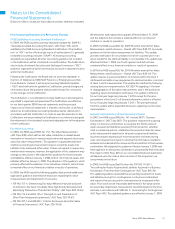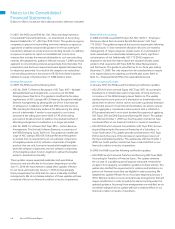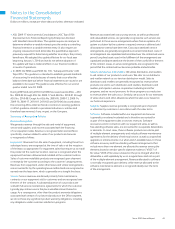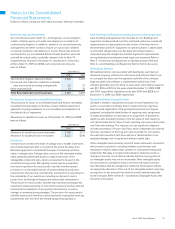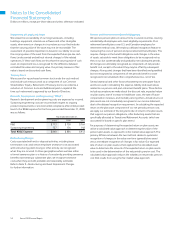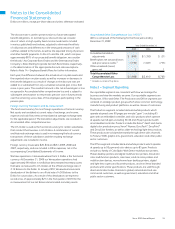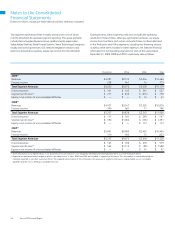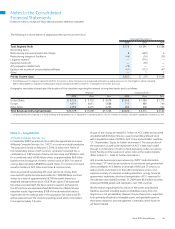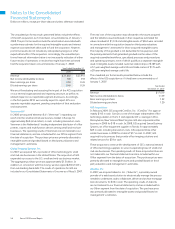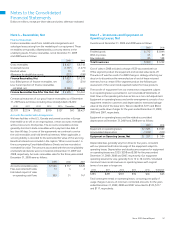Xerox 2009 Annual Report Download - page 49
Download and view the complete annual report
Please find page 49 of the 2009 Xerox annual report below. You can navigate through the pages in the report by either clicking on the pages listed below, or by using the keyword search tool below to find specific information within the annual report.
47Xerox 2009 Annual Report
Notes to the Consolidated
Financial Statements
Dollars in millions, except per-share data and unless otherwise indicated.
We elected to early-adopt these updates effective March 31, 2009
and the adoption did not have a material effect on our financial
condition or results of operations.
In 2009, the FASB issued ASU No. 2009-05 which amends Fair Value
Measurements and Disclosures – Overall (ASC Topic 820-10) to provide
guidance on the fair value measurement of liabilities. This update
provides clarification for circumstances in which a quoted price in an
active market for the identical liability is not available. This update was
effective October 1, 2009 (our fourth quarter) and did not have
a material effect on our financial condition or results of operations.
In 2010, the FASB issued ASU No. 2010-06 which amends Fair Value
Measurements and Disclosures – Overall (ASC Topic 820-10). This
update requires a gross presentation of activities within the Level 3
roll-forward and adds a new requirement to disclose transfers in and out
of Level 1 and 2 measurements. The update also clarifies the following
existing disclosure requirements in ASC 820-10 regarding: i) the level
of disaggregation of fair value measurements; and ii) the disclosures
regarding inputs and valuation techniques. This update is effective
for our fiscal year beginning January 1, 2010, except for the gross
presentation of the Level 3 roll-forward information, which is effective
for our fiscal year beginning January 1, 2011. The principle impact
from this update will be expanded disclosures regarding our fair value
measurements.
Business Combinations and Noncontrolling Interests
In 2007, the FASB issued SFAS No. 141 (revised 2007), “Business
Combinations” (ASC Topic 805). This guidance requires the acquiring
entity in a business combination to recognize the full fair value of
assets acquired and liabilities assumed in the transaction (whether
a full or partial acquisition); establishes the acquisition date fair value
as the measurement objective for all assets acquired and liabilities
assumed; requires expensing of most transaction and restructuring
costs; and requires the acquirer to disclose the information needed to
evaluate and understand the nature and financial effect of the business
combination. We adopted this guidance effective January 1, 2009 and
have applied it to all business combinations prospectively from that date.
The impact of ASC Topic 805 on our consolidated financial statements
will depend upon the nature, terms and size of the acquisitions we
consummate in the future.
In 2009, the FASB issued Staff Position No. FSP FAS 141(R)-1,
“Accounting for Assets Acquired and Liabilities Assumed in a Business
Combination That Arise from Contingencies” (ASC Topic 805-20).
This updated guidance amended the accounting treatment for assets
and liabilities arising from contingencies in a business combination
and requires that pre-acquisition contingencies be recognized at fair
value, if fair value can be reasonably determined. If fair value cannot
be reasonably determined, measurement should be based on the best
estimate in accordance with SFAS No. 5, “Accounting for Contingencies”
(ASC Topic 405). This updated guidance was effective January 1, 2009.
New Accounting Standards and Accounting Changes
FASB Establishes Accounting Standards Codification™
In 2009, the FASB issued Accounting Standards Update No. 2009-01,
“Generally Accepted Accounting Principles” (ASC Topic 105), which
establishes the FASB Accounting Standards Codification (“the Codi fica-
tion” or “ASC”) as the official single source of authoritative U.S. generally
accepted accounting principles (“GAAP”). All existing accounting
standards are superseded. All other accounting guidance not included
in the Codification will be considered non-authoritative. The Codification
also includes all relevant Securities and Exchange Commission (“SEC”)
guidance organized using the same topical structure in separate sections
within the Codification.
Following the Codification, the Board will not issue new standards in
the form of Statements, FASB Staff Positions or Emerging Issues Task
Force Abstracts. Instead, it will issue Accounting Standards Updates
(“ASU”) which will serve to update the Codification, provide background
information about the guidance and provide the basis for conclusions
on the changes to the Codification.
The Codification is not intended to change GAAP, but it will change the
way GAAP is organized and presented. The Codification was effective
for our third-quarter 2009 financial statements and the principal
impact on our financial statements is limited to disclosures, as all future
references to authoritative accounting literature will be referenced in
accordance with the Codification. In order to ease the transition to the
Codification, we are providing the Codification cross-reference alongside
the references to the standards issued and adopted prior to the adoption
of the Codification.
Fair Value Accounting
In 2006, the FASB issued SFAS No. 157, “Fair Value Measurements”
(ASC Topic 820) which defines fair value, establishes a market-based
framework or hierarchy for measuring fair value and expands disclosures
about fair value measurements. This guidance is applicable whenever
another accounting pronouncement requires or permits assets and
liabilities to be measured at fair value. It does not expand or require any
new fair value measures; however, the application of this statement may
change current practice. We adopted this guidance for financial assets
and liabilities effective January 1, 2008 and for non-financial assets and
liabilities effective January 1, 2009. The adoption of this guidance, which
primarily affected the valuation of our derivative contracts, did not have
a material effect on our financial condition or results of operations.
In 2009, the FASB issued the following updates that provide additional
application guidance and enhance disclosures regarding fair value
measurements and impairments of securities:
•FSP FAS 157-4, “Determining Fair Value When the Volume and Level
of Activity for the Asset or Liability Have Significantly Decreased and
Identifying Transactions That Are Not Orderly” (ASC Topic 820-10-65).
•FSP FAS 115-2 and FAS 124-2, “Recognition and Presentation of
Other-Than-Temporary Impairments” (ASC Topic 320-10-65).
•FSP FAS 107-1 and APB 28-1, “Interim Disclosures about Fair Value
of Financial Instruments” (ASC Topic 320-10-65).


